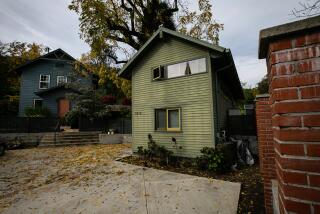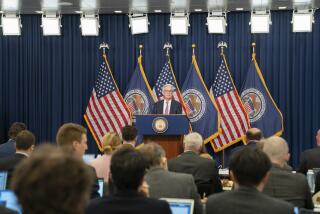Ruffling Feathers Old Business at Costa Mesa S
- Share via
It wasn’t long ago that an Orange County-based S&L; figured prominently in Federal Home Loan Bank Board Chairman Edwin Gray’s every speech about the evils of deregulation.
He never named it, but when Gray related with dismay that there was an S&L; that invested in wind farms, it didn’t take much to figure out that he was talking about American Diversified Savings Bank of Costa Mesa.
American Diversified--with its investments in a wind farm in Northern California, an ethanol production facility in Kansas and a cellular telephone business in Orange County--has been raising eyebrows throughout the industry
Among the reasons:
- While the traditional role of a savings and loan is to make home loans, American Diversified reported that only 8.5% of its assets invested in such loans as of Dec. 31, 1984. That was the lowest percentage of any of the largest 1,000 savings associations in the nation (the next lowest was at 32%) and was the lowest figure of any California S&L.; (American Diversified is the 256th-largest S&L; in the country, with assets of $789.5 million. It ranked 40th in California out of 200 S&Ls; in operation in the state last year.)
- At year’s end, 55.1% of its deposits were generated by outside brokers, a practice frowned upon by regulators. That total was down from a staggering 95% a year earlier, but still was the seventh highest of the 1,000 largest S&Ls; in the country and the fourth highest of all California associations.
- American Diversified had 66% of its assets, $521.3 million, in equity investments in its subsidiaries on Dec. 31, 1984--the highest percentage of any of the nation’s 1,000 largest thrifts. It was also the highest rate of any California S&L;, regardless of size. (Recently revised federal regulations now mandate that even state-chartered S&Ls; limit direct investments in real estate or subsidiary businesses to no more than 10% of their total assets.)
- The association’s assets increased 236% in calendar 1984 on top of a nearly 500% increase the previous year.
And with $897 million in assets and $11.2 million in profits as of June 30, the S&L; is still growing.
But company executives say they believe Gray, and the industry, have recently come to accept them because they now are treading a more traditional path. They say the thrift is changing.
Playing by the Rules
American Diversified--founded by Ranbir Sahni, a former Indian Air Force and TWA pilot who owns 96% of the company--is now trying to play by the rules and no longer wants to ruffle regulatory feathers.
“We are somewhat different from other S&Ls;,” admits Lester Day, American Diversified’s president. “But our philosophy now, because of the political climate, is to undertake a more traditional path than we did in the early years. We are changing our business so that we are reflecting what is expected and mandated.”
In those changes is found a graphic example of the give and take between regulators and the regulated.
Chief among the bank board’s concessions is an agreement to let American Diversified grow at almost double the rate imposed on other S&Ls.; American Diversified will be able cut its huge investments in non-traditional subsidiaries “very slowly,” Day said, meaning the S&L; will remain among the most heavily invested in the nation for years to come. For instance, in its June 30 report, Day said, investments in subsidiaries had decreased to 62% of assets, from 66% at year-end. But the dollar figure had climbed to $555.3 million, from $521.3 million.
Changes aimed at making American Diversified a more traditional S&L; include a shift away from selling real estate syndications; the winding down of the company’s involvement in wind farms and ethanol production facilities and the start-up of a new mortgage banking division, Day said.
Fewer Brokered Deposits
American Diversified also is working hard to reduce its reliance on brokered deposits in the face of bank board Chairman Gray’s conviction that the use of expensive brokered deposits is both a major cause of S&L; failures and a symptom that an S&L; is in trouble.
Day said the association now has much less brokered money coming in. According to figures provided by Day, brokered deposits had dropped to 16.3% of American Diversified’s total deposits on June 30. Day said the percentage “should be almost zero by the end of the year.”
Industry sources said company officials presented a new business plan to Federal Home Loan Bank officials in May, promising to reduce the S&L;’s huge direct investment in its subsidiaries; to stop using independent money brokers to obtain deposits, and to begin making more mortgage loans and to spread out the S&L;’s investments so it is not dependant on a single segment of the real estate market for its revenue.
In return, sources said, the bank board agreed to allow American Diversified to increase deposits and assets by about 25% a year, despite a rule imposed in February that limits annual growth to 15%.
In a recent interview, Day confirmed that the meeting took place, but would not discuss the agenda. He did say, however, that American Diversified’s new business plan calls for the association to increase its assets and deposits by about 25% a year. The company successfully argued to bank board officials that the thrift needed the additional expansion in order to make the business plan work.
Still Has Problems
Despite its strong growth and penchant for innovation, the savings bank has had its share of troubles in the past 15 months.
And there are still more problems to be resolved at the company, where a furious growth spurt over the past two years caused a personnel upheaval that resulted in a spate of lawsuits by former management-level employees. The suits, filed in Orange County Superior Court, allege that several of American Diversified’s subsidiaries were involved in improper or illegal activities relating to the sale of real estate limited partnerships.
Some of those allegations were at the root of last year’s Securities and Exchange Commission and National Assn. of Securities Dealers investigations of American Diversified’s real estate and energy syndication operations.
However, executives at American Diversified said the company has resolved all of its regulatory problems and emerged from a 15-month period in which the S&L; and its subsidiaries chalked up a cumulative loss of more than $4.5 million, as a stronger entity.
Indeed, the company is one of the largest builders in the country. In its May issue, Builder magazine ranked American Diversified as the fifth-largest privately owned builder of rental units in the county and as the nation’s seventh-largest home builder overall.
American Diversified Capital Corp., a subsidiary of the S&L;, “has sold at least $200 million of (real estate) product in the last few months,” according to Wyn Pope, the company’s executive vice president. “We have another $100 million or so under contract to sell and about $100 million more in negotiations” with various potential buyers, Pope said.
The profits that the direct sale of real estate generated for American Diversified in its final fiscal 1985 quarter followed losses of $4.5 million in the first quarter and $5.3 million in the third quarter and gave the company annual net income of $2.2 million. Despite the earlier quarters’ losses, Day said that the company has never posted an annual loss.
Official numbers have not yet been released by the bank board. But Day, who holds the remaining 4% of the corporation, said the company posted an $11.2-million profit for the fourth quarter of its 1985 fiscal year, which ended June 30. Figures for the first quarter of fiscal 1986 won’t be available until the end of the year. The fourth-quarter profit came largely from gains on the sale of real estate.
More to Read
Inside the business of entertainment
The Wide Shot brings you news, analysis and insights on everything from streaming wars to production — and what it all means for the future.
You may occasionally receive promotional content from the Los Angeles Times.










